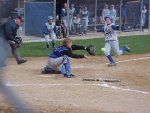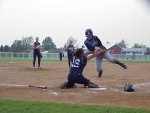Interesting conversation with DD's catching coach about blocking the plate without the ball:
I learned everything I know about catching from the Weaver's, and setup for a play at the plate means up the 3rd base line and inside the line until you have the ball, then drop left across the baseline. This is also how her team coaches have done it.
DD's coach played DII ball a few years back, and she straddles the line 1' up the baseline, feet wide apart, waiting for the ball, then drop on the line w/ knees together when the ball arrives.
In her mind, and apparently without any objection from the officials in her "era", this still leaves the runner access to the plate by sliding under her.
I was curious how the majority of umpires are calling this, and if it has evolved over the years.
I learned everything I know about catching from the Weaver's, and setup for a play at the plate means up the 3rd base line and inside the line until you have the ball, then drop left across the baseline. This is also how her team coaches have done it.
DD's coach played DII ball a few years back, and she straddles the line 1' up the baseline, feet wide apart, waiting for the ball, then drop on the line w/ knees together when the ball arrives.
In her mind, and apparently without any objection from the officials in her "era", this still leaves the runner access to the plate by sliding under her.
I was curious how the majority of umpires are calling this, and if it has evolved over the years.








